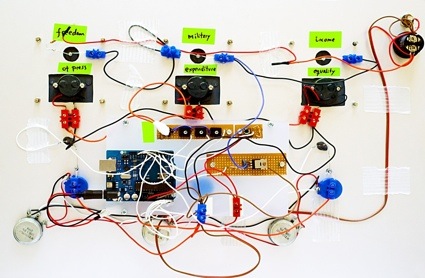 OECDlab, Qui magistratum obeunt mundum credunt sibi subiectum esse ut ad suam voluntatem flectatur (Interior)
OECDlab, Qui magistratum obeunt mundum credunt sibi subiectum esse ut ad suam voluntatem flectatur (Interior)
It’s hard to believe that it took me so many years to finally email Mogens Jacobsen and ask him for an interview. I’ve been following his projects since the very beginning of the blog (which was 8 years ago, in case you were wondering.)
Jacobsen is a media artist based in Copenhagen and an Adjunct Professor in Digital Culture and Mobile Communication at IT University, Copenhagen. His artistic work either closely follows social, political and ethical questions or sabotages technology, by mix-matching new and old media or by inviting web users to subvert web banners.
Some of his most acclaimed works include Crime Scene, two computers swapping copyrighted material in full view of the public; Power of Mind 3 Dissociative Defense, an installation powered by potatoes and hosting a report on human rights in Denmark; and TurntablistPC, a series of vintage turntables that spin their record according to visits to certain websites.
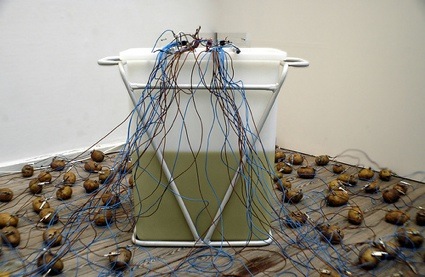 Power of Mind 3 Dissociative Defense
Power of Mind 3 Dissociative Defense
One of his most recent pieces, OECDlab comments on the cult for data and more precisely the instrumentalization of statistics by politicians, academics and economists. By manipulating the levers, dials, and knobs of three retro-looking lab-instruments, people can adjust parameters like percentage of women in parliament, distribution of income, military expenditure and see how these alterations are influencing other factors in society. The countries remain anonymous but all the data used is real data supplied by OECD, the WorldBank and UN.
I was curious to know more about OECDlab and that was the excuse i needed to finally get in touch with Mogens Jacobsen and discover if he could possibly be wittier than his own artworks:
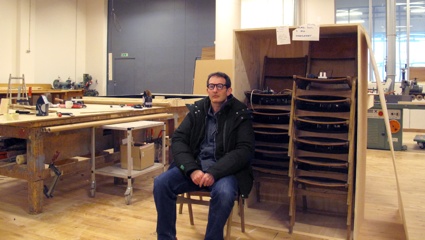 Mogens Jacobsen in his workshop (photo courtesy of the artist)
Mogens Jacobsen in his workshop (photo courtesy of the artist)
Your work often responds to current social and cultural issues: human rights in Denmark, the rise of surveillance, file sharing, interactivity/reactivity, etc. What do you think are the themes that should be urgently addressed right now? Either by you or by other artists? Do you think that artists have any impact on ethical, cultural or social issues? Can they change the way a problem or situation is perceived and handled?
I’m sad to say this – but I wouldn’t overestimate the impact done by artists at the moment. I wish more media artist would deal with real-world, everyday political issues. There seem to be a rather dominating escapist interest in phenomenology and the individual spectator. A problem I personally blame on the “experience economy” focus some years back. Now the “money” economy has crashed and experience economy has become unfashionable, it might be a good time to make art relevant outside the safe haven of the established art spaces again.
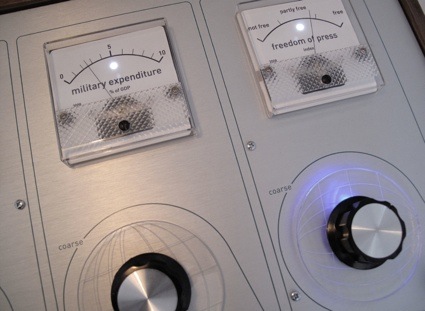 OECDlab, The “Qui magistratum obeunt mundum credunt sibi subiectum esse ut ad suam voluntatem flectatur” instrument (Detail)
OECDlab, The “Qui magistratum obeunt mundum credunt sibi subiectum esse ut ad suam voluntatem flectatur” instrument (Detail)
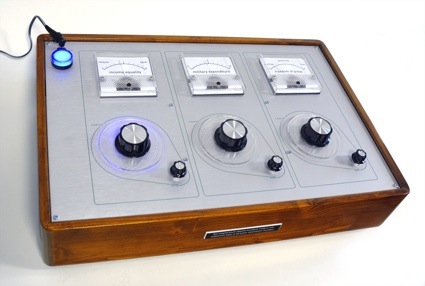 OECDlab, The “Qui magistratum obeunt mundum credunt sibi subiectum esse ut ad suam voluntatem flectatur” instrument
OECDlab, The “Qui magistratum obeunt mundum credunt sibi subiectum esse ut ad suam voluntatem flectatur” instrument
By turning the knobs of the OECDlab instruments, people can manipulate different parameters such as the percentage of women in parliament, distribution of income (the GINI index), military expenditure, etc. and then see how the alterations are influencing other factors in society. Can the manipulation ever lead to a satisfactory situation? One with maximum freedom of the press, one without shocking income inequality, etc.
One of the things that surprised me was the chaotic behavior of the instruments. Naively I thought there might be some correspondence between parameters such as freedom of press and distribution of wealth. But not so.
The OCEDlab lets you explore the world as it is – according to statistics at least, not construct a personal utopia. On one of the instruments, the one titled “Qui magistratum obeunt mundum credunt sibi subiectum esse ut ad suam voluntatem flectatur”, you will never be shown the name of the country as you try to combine parameters. So it is not a travel/emigration-guide, but more a disrupting guide through your own beliefs of social-economic politics.
Have you thought of making an online version of the OECDlab?
I have thought of an online version. But of course I won’t do it. I am really trying to avoid screens and fancy visuals at the moment. It like a personal struggle to be in the “media arts” and not revert to amazingly colorful pixels on a screen. Ten years ago I said Flash spoiled net.art by pulling the attention towards the surface. So now I really try hard to avoid the screen altogether.
And basically all data of the OECDlab is already available online on the website of the OCED, the Worldbank, UN and a couple of other sites. So you can easily access the data, which was what I did as I started on the project.
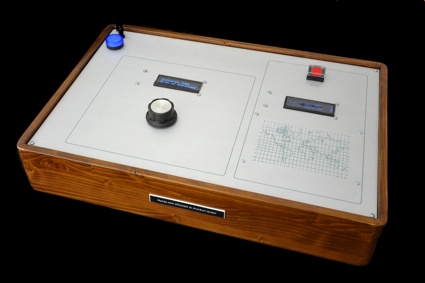 OECDlab, The “Manda mihi officinam et mundum levabo” instrument
OECDlab, The “Manda mihi officinam et mundum levabo” instrument
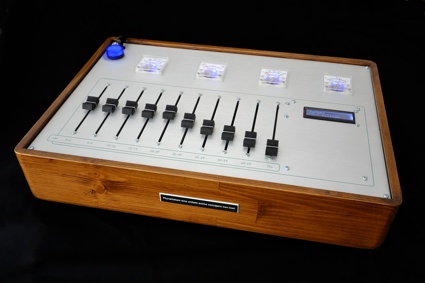 OECDlab, The “Pluralitatem sine unitate animo concipere non licet” instrument
OECDlab, The “Pluralitatem sine unitate animo concipere non licet” instrument
I’m also interested in the reason why you gave the instrument such a retro look. Why not present them with fancy touch screens and spectacular infographics?
The project OECDlab is deliberately looking quite old – like the apparatus of science, at a time when science was thought to be objective, when science was trusted and thus allowed to control society without anyone questioning the facts.
So OECDlab looks like the nostalgic technical tools of objective power. Like test-equipment in a lab or instruments from the science lab of a school: Dark polished wood, analogue meters and large knobs.
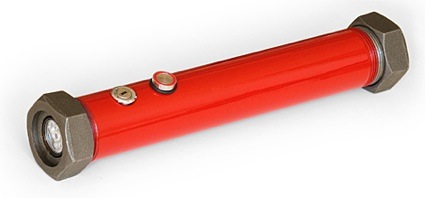
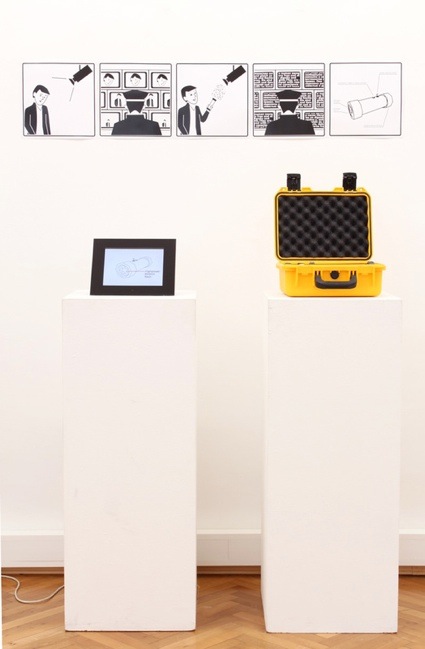 The Democratic Dazzler. Image Black Box Gallery
The Democratic Dazzler. Image Black Box Gallery
Have you tested the Democratic Dazzler or the Oplyser (two devices that disrupt surveillance systems and transmits by Morse code article 1 of the United Nations Universal Declaration of Human Rights) on security cameras in public space? How did it go? Did you get any reaction? Either from passersby or from the people who are monitoring the surveillance cameras?
The Dazzler project started when I was invited the Danish gallery “Torpedo 18”, which is a gallery for “inaccessible art”. What a freedom to get invited to do something inaccessible! As the first version of Dazzler was working, I wanted to do a small presentation of the project. So I arranged an event in front of the Danish Supreme Court one evening at 8 PM. Only a very few friends showed up at this event. But as the clock struck 8, I thought I needed to do some sort of welcome. So I stepped up a small staircase, raised the Dazzler and was getting ready to speak. Then the door behind me opened and the – at that time – Danish prime minister Anders Fog Rasmussen (now Secretary General of NATO) stepped with his security guards. Everybody – including myself – were quite baffled. The prime minister quickly got in this limo and drove off. Sadly nobody took a photo.
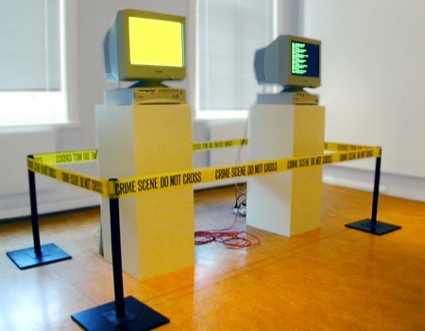 Crime Scene
Crime Scene
Your work Crime Scene (in which two computers exchange copyrighted works) is illegal to show in Denmark. What happened? Did you get into legal troubles because of the installation?
At the time I was working in a small ground with some people from museums and cultural institutions around Denmark. And all were really scared of showing digital art due to unsolved questions regarding intellectual rights. I really tried to understand the Danish copyright laws but was baffled. And nobody was really capable of answering my questions.
So instead I made this piece, not as a provocation or protest, but more as my way of stating a question. I was approached by some lawyers from the ministry of culture, who thought it was an interesting question. And they asked me if they could investigate it as a legal case (and they guarantied me I would not get into trouble). Well, the case ended by stating the piece was legal for me to produce – referring to artistic freedom and freedom of speech. But a museum wanting to exhibit the piece might get into trouble.
So far, the Crime Scene has been shown in Sweden, Spain and France. But it has never been shown in Denmark.
You define yourself as a media artist. Is this a ‘label’ you find important? Would it be just the same to you to say you’re a ‘contemporary artist’?
It does matter that much for me. I used the “media” label to put some distance to painting and graphics (even thing happening on a monitor). I would like to get the attention away from the visual imagery. “Media” sort of covered a lot of thing – and as “new media” has grown old, I settled on just using the word “media”.
What kind of advice would you give to someone who would like to establish themselves as a media artist as well?
First of all – and very important – get some way of having an income. Artists don’t make money. And media artists certainly do not, as nobody is buying media art.
Then secondly: Learn to program. Any programming language: C#, C, Java, processing whatever lingo that fits your needs and abilities. It might sound very old fashioned – focusing on learning the craft. But it gives you a lot more freedom sketching things out in the actual medium, not only working on the conceptual level. And let you experiment without having to beg, bribe or pay somebody else.
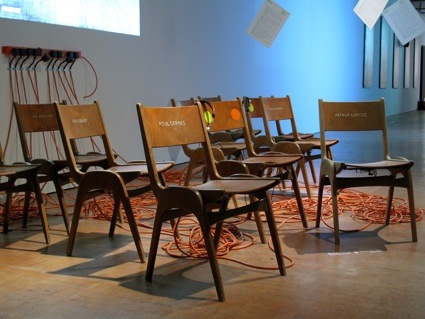 Pairs – Conversation Piece from 1965. Installation view at ZKM (in progress)
Pairs – Conversation Piece from 1965. Installation view at ZKM (in progress)
Are there any upcoming projects you could share with us?
I have some things coming up. A new piece for a group show with the theme “money”. This might end up with another apparatus in the style of OECDlab. Also I will be showing some works at the exhibition Audio Art – Sound as Medium for the Arts at ZKM in Germany. The exhibition opens on March 16th. And one of my contributions is a new piece which I’m really busy making right now. The working title is Pairs – Conversation Piece from 1965. It is based on a note from one meeting between several Danish artists in 1965. Each artist will be represented by an old wooden chair, and rearranging the chairs you will be navigating between their discussions.
Thanks Mogens!
